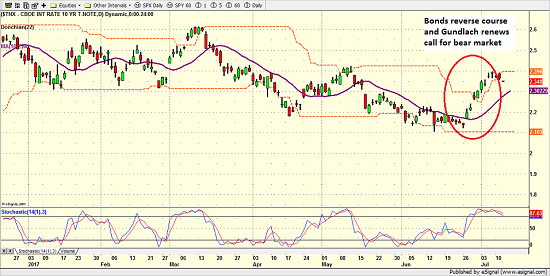Don’t look now fans, but bonds may be back on the list of things to worry about in the stock market. Jeff Gundlach, who has apparently been anointed the new king of the bond market, has suggested that bonds are on the precipice of a bear market and that Ten-year Treasury yields are on course to move “toward 3 percent” this year.
Just over two weeks ago, the yield on the U.S. Gov’t 10-Year closed at the low of the year at 2.137%. The thinking at the time was that inflation indicators were wobbling, the economic outlook was mixed, and the chances of Trump getting anything done in 2017 were falling fast. So, despite all the Fedspeak to the contrary, the markets doubted the Fed’s ability to stay the course. Rates looked to be moving in the opposite direction of the general consensus.
Lest we forget, the yield on the 10-year began 2017 at 2.446% and just about everyone on the planet expected that yield to rise steadily throughout the year. So, when yields dropped to a fresh calendar-year low on June 26, it appeared that the prognosticators of doom and gloom in the bond market had once again failed – in rather spectacular fashion.
However, eight days later, the yield on the 10-year had spiked to 2.396% and looked ready to take out important resistance zones. The move was impressive – and global in scope. And those who don’t spend their days watching the action in markets, were left scratching their heads.
Yield of U.S. Gov’t 10-Year – Daily

So, what gives? Why did bond yields reverse course in violent fashion? Why did the sentiment flip completely in such a short period of time?
No, Janet Yellen didn’t change her tune. No, the Fed didn’t surprise the markets at their June meeting. And no, the inflation data hadn’t suddenly reversed.
The answer actually has nothing to do with the United States economic data, nor inflation, oil, or even the Fed. Nope, this situation started across the pond – and not where you might think.









Leave A Comment